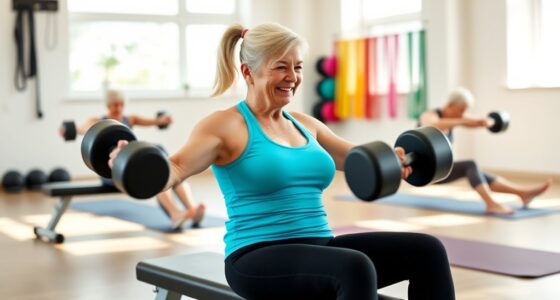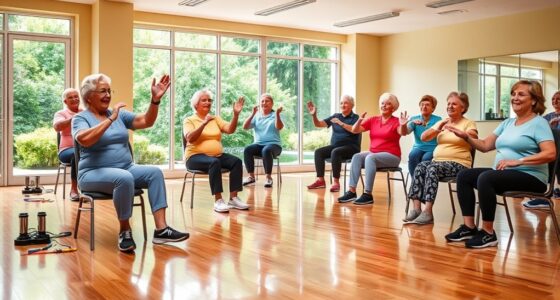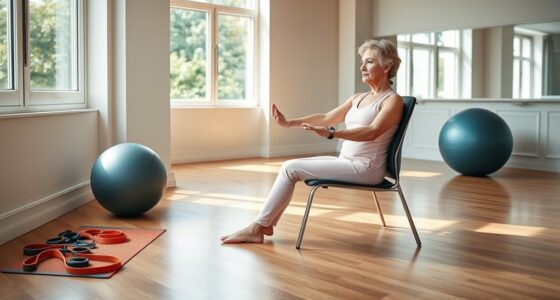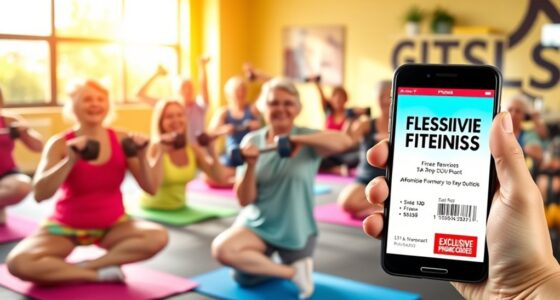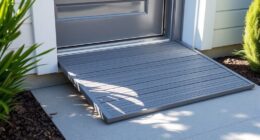Exercise for seniors can truly revolutionize your routine, giving you more energy and improving your overall well-being. Regular physical activity cuts your risk of chronic diseases, boosts mood, and enhances cognitive function. Incorporating activities like tai chi for balance and strength training for muscle mass will strengthen your body and prevent falls. Plus, joining group classes can provide a social boost while keeping you motivated. Discover more ways to transform your exercise regimen and embrace an active lifestyle!
Key Takeaways
- Incorporate strength training twice a week to maintain muscle mass, enhancing mobility and independence in daily activities.
- Engage in low-impact aerobic exercises like swimming or walking to improve cardiovascular health and elevate mood.
- Add balance exercises such as tai chi three times a week to reduce fall risk and enhance stability.
- Join group fitness classes for social engagement and motivation, making exercise enjoyable and sustainable.
- Set realistic goals and gradually increase exercise intensity to foster a sense of accomplishment and long-term commitment.
Health Benefits of Exercise for Seniors
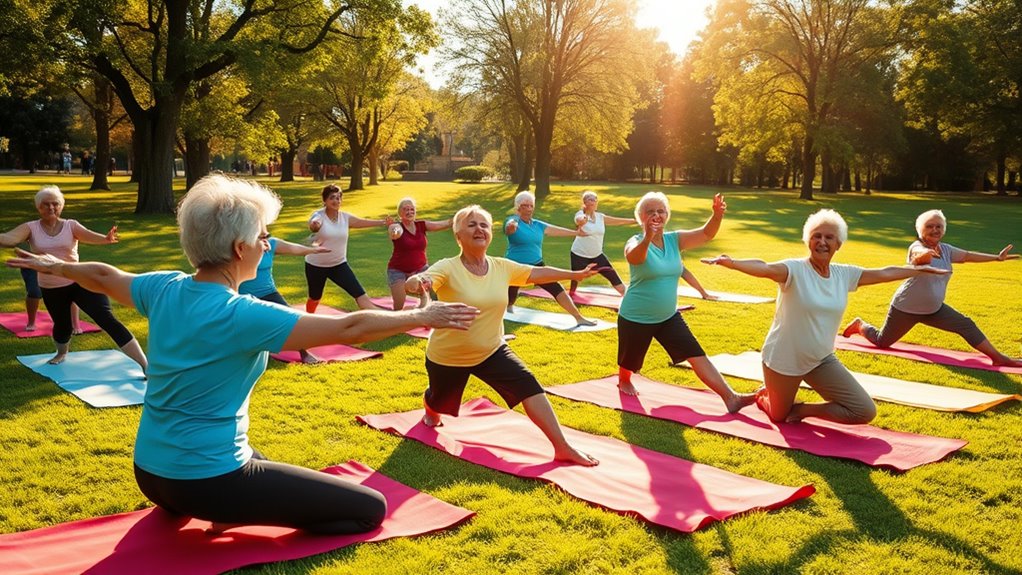
When you make exercise a regular part of your routine, you’re not just staying active; you’re also greatly boosting your health and longevity.
The health benefits of exercise for seniors are profound. Regular physical activity can reduce the risk of chronic diseases like heart disease and diabetes, improving your overall health. It also enhances balance and strength, leading to a significant reduction in the risk of falls. Additionally, incorporating omega-3 rich foods like chia seeds into your diet can further support heart health, complementing your exercise efforts. Chia seeds are high in fiber, which promotes satiety and can help with weight management. Advance directives can also help ensure that your health care preferences are respected as you age. Furthermore, animal companionship can motivate seniors to engage in more physical activity, providing both joy and exercise.
Furthermore, exercise helps improve cardiovascular health and can elevate your mood, reducing symptoms of depression and boosting cognitive function. Staying active increases energy levels and improves sleep quality, essential for maintaining an independent lifestyle. Additionally, engaging in exercise can provide companionship and reduce feelings of social isolation, which is especially important for those dealing with conditions like dementia or Parkinson’s.
Ultimately, engaging in exercise enhances your quality of life, promoting social interaction and community engagement.
Recommended Types of Exercises for Seniors
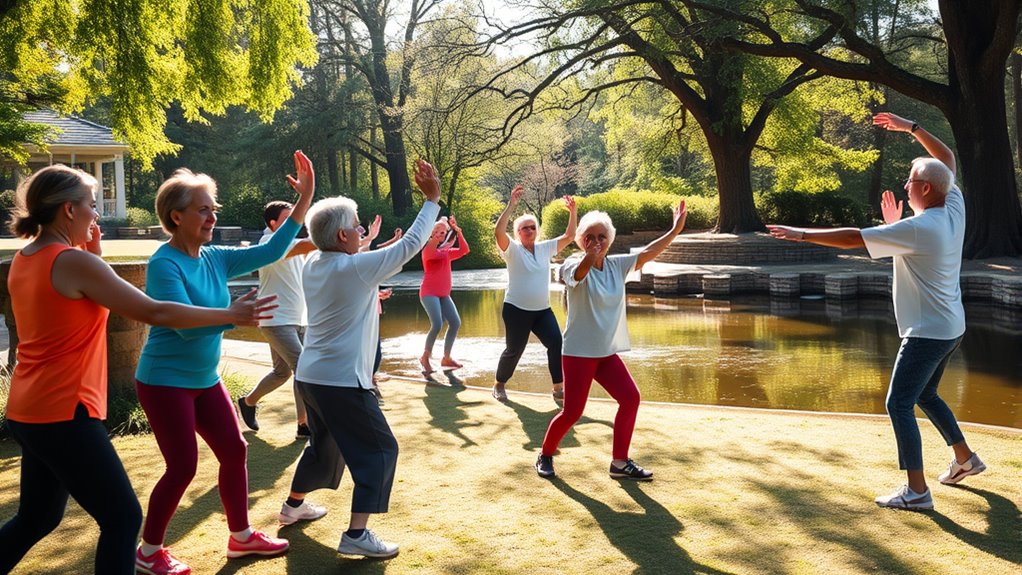
As you age, incorporating the right types of exercises into your routine can make a considerable difference in your health and well-being.
For strength training, aim for muscle-strengthening activities twice a week to help maintain muscle mass and bone density. Knowing your local gym operating hours can help you schedule these sessions effectively. Engaging in educational and skill-building toys can also support physical activity, keeping both mind and body active. Additionally, incorporating astrological compatibility into your self-image can boost confidence, which may enhance your exercise motivation. Regular physical activity can significantly contribute to overall psychological growth as you age.
Low-impact aerobic exercises, like swimming or water aerobics, provide great cardiovascular benefits while being gentle on your joints.
Low-impact aerobic exercises, such as swimming, are excellent for heart health while being easy on your joints.
Don’t overlook balance exercises—practicing tai chi or heel-to-toe walking three times a week can considerably reduce falls risk.
Additionally, flexibility and stretching exercises should be part of your daily routine to improve range of motion. Regular attendance at a gym can enhance your commitment to maintaining this flexibility routine.
Consider joining group fitness classes, such as Zumba Gold or chair yoga, to stay socially engaged while enhancing your exercise routine and overall well-being.
Moreover, establishing a routine can significantly improve adherence to regular exercise, just as it does for infants in sleep training.
Incorporating Balance and Mobility Activities
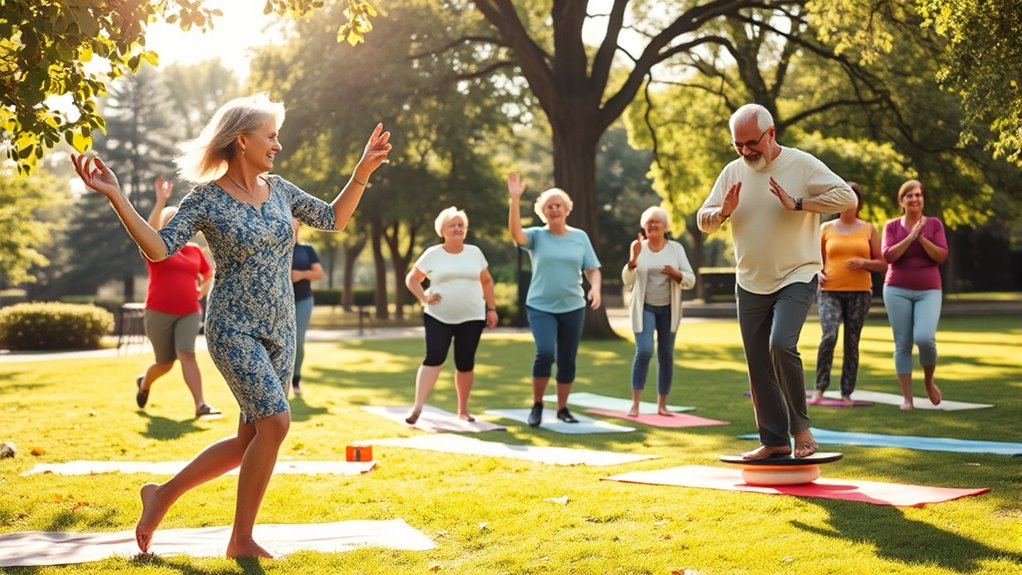
Building on the foundation of strength and aerobic exercises, integrating balance and mobility activities into your routine can greatly enhance your stability and overall health. These exercises can also be vital in strategic planning for smooth separation, as maintaining physical well-being can support emotional resilience during challenging times. Engaging in these activities can help foster a sense of emotional support during separation that is crucial for overall wellness. Additionally, regular physical activity can help alleviate cognitive decline, which is often a concern for seniors. Incorporating essential survival gear into your daily routine can also prepare you for unexpected situations that may arise as you age.
By incorporating these activities, you can reduce the risk of falls and maintain your independence in daily activities. Aim to practice balance exercises three times a week, and consider the following:
- Standing on one leg
- Heel-to-toe walking
- Hip rotations
- Ankle circles
- Tai chi or yoga sessions
These mobility exercises improve flexibility and coordination, ultimately boosting your confidence in movement. Regularly engaging in these activities can also support your financial planning for assisted living needs as you age.
With regular practice, you’ll notice increased stability, allowing you to navigate uneven surfaces with ease. Embrace these activities for a healthier, more active lifestyle!
Creating a Sustainable Exercise Routine
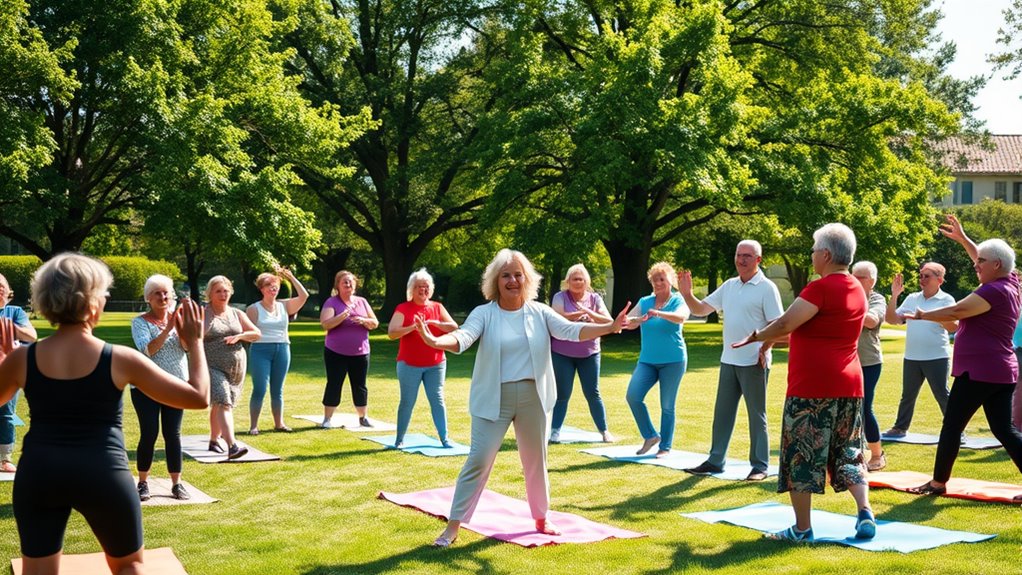
Creating a sustainable exercise routine is essential for maintaining your health and independence as you age. Aim for at least 150 minutes of moderate aerobic activity each week, breaking it down into manageable sessions of 10 or 15 minutes.
Mix activities like walking, swimming, and strength training at least twice a week to boost muscle strength and overall fitness. Don’t forget to include balance and flexibility exercises daily, such as tai chi or gentle stretching, to enhance mobility and reduce fall risks.
Set realistic goals, gradually increasing your workout intensity and duration to keep things enjoyable.
Finally, take advantage of community resources like group classes or online videos tailored for seniors, providing motivation and social interaction in your routine.
Overcoming Barriers to Staying Active
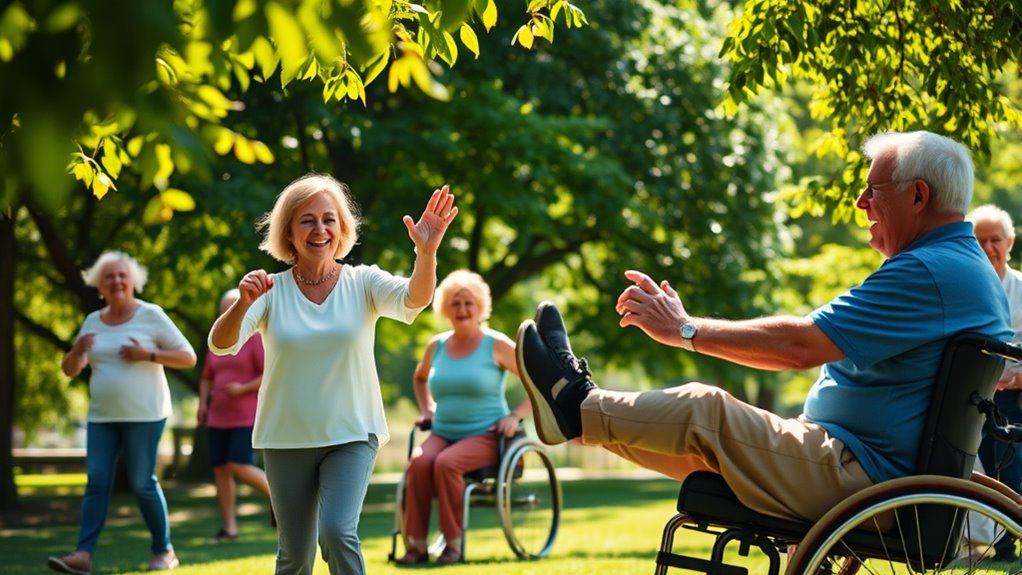
While it might seem challenging to stay active as you age, recognizing and addressing personal barriers can make a significant difference.
Start by identifying what holds you back, and you can tailor your exercise regimen to fit your lifestyle. Here are some strategies for overcoming barriers:
- Set realistic fitness goals to maintain a positive mindset.
- Incorporate low-impact activities like walking or stretching into your daily routine, as these activities can be beneficial for maintaining joint health. Regular participation in mindfulness practices can also help enhance your focus and motivation during exercise. Additionally, engaging in digital literacy programs can foster a sense of community, further encouraging you to stay active. Ensuring your exercise environment is safe, similar to newborn safety guidelines, can also help you feel more comfortable and secure while being active.
- Join community fitness groups for motivation and accountability.
- Focus on self-motivation by celebrating small achievements.
- Gradually increase physical activity to avoid feeling overwhelmed. Additionally, incorporating self-care practices into your routine can enhance your overall well-being and support your fitness journey.
Frequently Asked Questions
What Is the Number One Exercise for Seniors?
The number one exercise for seniors is walking. It’s a low-impact activity that you can easily fit into your daily routine.
By aiming for 10,000 steps a day, you can greatly lower your mortality risk and improve your overall health. Walking strengthens your bones and muscles, helps maintain a healthy weight, and boosts your energy levels.
Plus, it enhances your balance and coordination, reducing your risk of falls. So, grab your shoes and start strolling!
What Is the Number 1 Exercise to Increase Balance in Seniors?
Imagine standing tall like a sturdy tree, roots gripping the ground.
The number one exercise to increase balance in seniors is the single leg balance. By lifting one leg and holding your position, you’re not just working your muscles; you’re building a fortress against falls.
Aim to practice this three times a week, integrating it into daily tasks. You’ll feel your coordination improve, boosting your confidence and mobility as you embrace life’s adventures!
What Is the 5 5 5 30 Exercise?
The 5 5 5 30 exercise routine is a practical approach to fitness, combining different exercise types.
You perform 5 minutes of aerobic activity to boost your heart health, followed by 5 minutes of strength training to build muscle.
Then, you engage in 5 minutes of balance exercises to enhance stability, finishing with 30 seconds of stretching for flexibility.
This routine’s designed to fit easily into your day, promoting consistent physical activity and overall well-being.
Which Type of Exercise Is Most Strongly Recommended for Older Adults?
The most strongly recommended type of exercise for you as an older adult combines moderate aerobic activities like walking or swimming.
Aim for at least 150 minutes a week to boost your cardiovascular health.
Don’t forget to include muscle-strengthening exercises at least twice a week, focusing on major muscle groups, and practice balance exercises like tai chi three times a week to prevent falls.
Daily stretching routines will also help maintain your flexibility and comfort.
Conclusion
Incorporating exercise into your routine can truly transform your health and well-being as a senior. Did you know that just 150 minutes of moderate activity each week can reduce the risk of chronic diseases by up to 50%? By embracing a mix of strength, balance, and mobility exercises, you can enhance your quality of life. Remember, it’s never too late to start! So, lace up those sneakers, and make movement a joyful part of your day.


